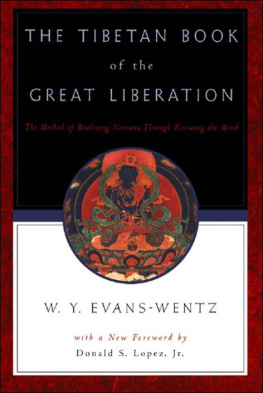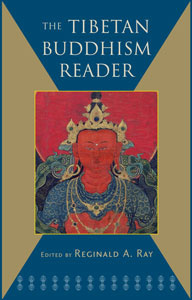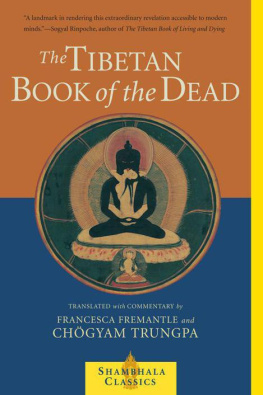THE TIBETAN BOOK OF THE
GREAT LIBERATION
OR THE METHOD OF
REALIZING NIRV  A THROUGH
A THROUGH
KNOWING THE MIND

THE GREAT GURU PADMA-SAMBHAVA
Described on pages xvxvi
THE TIBETAN BOOK OF THE
GREAT LIBERATION
OR
The Method of Realizing Nirv a
a
Through Knowing the Mind
Preceded by an Epitome of
Padma-Sambhavas Biography
and Followed by
Guru Phadampa Sangays Teachings
According to English Renderings by
Sardar Bahdur S. W. Laden La and
by the Lmas Karma Sumdhon Paul
Lobzang Mingyur Dorje, and
Kazi Dawa-Samdup
Introductions, Annotations and Editing by
W. Y. Evans-Wentz
With Psychological Commentary by
Dr. C. G. Jung
With a new Foreword by
Donald S. Lopez, Jr.


Oxford New York
Athens Auckland Bangkok Bogot Buenos Aires Calcutta
Cape Town Chennai Dar es Salaam Delhi Florence Hong Kong
Istanbul Karachi Kuala Lumpur Madrid Melbourne Mexico City Mumbai
Nairobi Paris So Paulo Singapore Taipei Tokyo Toronto Warsaw
and associated companies in
Berlin Ibadan
Copyright 1954, 2000 by W. Y. Evans-Wentz
First published by Oxford University Press, London, 1954
First issued as an Oxford University Press paperback, 1968
New Foreword copyright 2000 by Donald S. Lopez, Jr.
Published by Oxford University Press, Inc.,
198 Madison Avenue, New York, New York 10016
Oxford is a registered trademark of Oxford University Press
All rights reserved. No part of this publication may be reproduced,
stored in a retrieval system, or transmitted, in any form or by any means,
electronic, mechanical, photocopying, recording, or otherwise,
without the prior permission of Oxford University Press.
Library of Congress Cataloging-in-Publication Data
The Tibetan book of the great liberation, or, The method of realizing nirvana through knowing the mind ; preceeded by an epitome of Padma-Sambhavas biography and followed by Guru Phadampa Sangays teachings, according to English renderings by Sardar Bahadur S.W. Laden La and by the Lamas Karma Sumdhon Paul Lobzang Mingyur Dorje, and Kazi Dawa-Samdup ; introductions, annotations, and editing by W.Y. Evans-Wentz ; with psychological commentary by C.G. Jung ; with a new foreword by Donald S. Lopez, Jr.
p. cm.
ISBN 0-19-513315-3
1. Spiritual lifeBuddhismEarly works to 1800. 2. Padma Sambhava, ca. 717-ca. 762. 3. Rdzogs-chen (Ri-ma-pa)Early works to 1800. 4. BuddhismChinaTibetEarly works to 1800. I. Title: The Tibetan book of the great liberation. II. Title: Method of realizing nirvana through knowing the mind. III. Laden La, Sonam Wangfel, sardar bahadur, 1876-1936? IV. Lobzang Mingyur Dorje. V. Zla-ba-bsam-grub, Kazi, 1868-1922. VI. Evans-Wentz, W.Y. (Walter Yeeling), 1878-1965. VII. Jung, C.G. (Carl Gustav), 1875-1961.
BQ7800.T53 2000
294.3923dc21 00-022483
1 3 5 7 9 8 6 4 2
Printed in the United States of America
IN GRATEFUL REMEMBRANCE OF
THE GURUS
WHO INSPIRED THE
TRANSMISSION OF THIS BOOK AND
THE TWO PRECEDING BOOKS
IN THIS SERIES
TO THE PEOPLES OF THE
WESTERN WORLD
DEDICATED
TO THOSE
SEEKING WISDOM
Bondage and Liberation
I: BONDAGE
Upon Ignorance dependeth karma;
Upon karma dependeth consciousness;
Upon consciousness depend name and form;
Upon name and form depend the six organs of sense;
Upon the six organs of sense dependeth contact;
Upon contact dependeth sensation;
Upon sensation dependeth desire;
Upon desire dependeth attachment;
Upon attachment dependeth existence;
Upon existence dependeth birth;
Upon birth depend old age and death, sorrow, lamentation, misery, grief, and despair. Thus doth this entire aggregation of misery arise.
II: LIBERATION
But upon the complete fading out and cessation of Ignorance ceaseth karma;
Upon the cessation of karma ceaseth consciousness;
Upon the cessation of consciousness cease name and form;
Upon the cessation of name and form cease the six organs of sense;
Upon the cessation of the six organs of sense ceaseth contact;
Upon the cessation of contact ceaseth sensation;
Upon the cessation of sensation ceaseth desire;
Upon the cessation of desire ceaseth attachment;
Upon the cessation of attachment ceaseth existence;
Upon the cessation of existence ceaseth birth;
Upon the cessation of birth cease old age and death, sorrow, lamentation, misery, grief, and despair. Thus doth this entire aggregation of misery cease.
The Buddha, Samyutta Nikya, xxii. 9016
(based upon H. C. Warrens Translation).
PLATE II


THE TRANSLATORS AND THE EDITOR
Described on page xvii
FOREWORD
Donald S. Lopez, Jr.
A certain trepidation attends the decision to accept an invitation to write a foreword to new editions, published in 2000, of the four books of W. Y. Evans-Wentz: The Tibetan Book of the Dead, Tibets Great Yog Milarepa, Tibetan Yoga and Secret Doctrines, and The Tibetan Book of the Great Liberation. The four books in their old editions are already burdened with numerous prefaces, commentaries, and introductions, causing one to wonder what another preface could possibly add. It seems inevitable that the four books of Evans-Wentz will continue to outlive yet another generation of commentators, such that anything that a scholar might add today will only serve as material for a scholar some fifty years from now, who will demonstrate the biases and misunderstandings of a preface written fifty years ago, a preface that merely offers evidence of the fin de sicle Zeitgeist of those who once called themselves postmoderns.
The four books of Evans-Wentz are surely ground-breaking works, the first to bring translations of Tibetan Buddhist texts to the English-speaking public. Evans-Wentz was equally avant garde in his method, collaborating closely with Tibetan scholars, a practice that would not become common for another four decades, after the Tibetan diaspora began in 1959. Yet, for the scholar of the present day, looking back now more than seventy years to the publication of the first volume of the series, The Tibetan Book of the Dead, in 1927, the Tibetan tetralogy of W. Y. Evans-Wentz, although a product of our century, seems to have originated in another age. All four books assume the undifferentiated dichotomy of the materialist West and the mystic East, an East that holds the secret to the Wests redemption. Few of the concerns of scholarssuch as language or culture or historyare to be found in the books. Instead, the volumes are presented as repositories of a timeless wisdom preserved by the East, a wisdom that will someday save the West, ultimately overcoming the duality of the hemispheres to culminate in the Unity of Mankind. This apparently beatific vision has since been shown to be the product of a romantic Orientalism that viewed the traditions of Asia as a natural resource to be extracted and refined for the consumption of the West; the books thus mark a moment in the history of colonialism.
Next page




 A THROUGH
A THROUGH
 a
a


